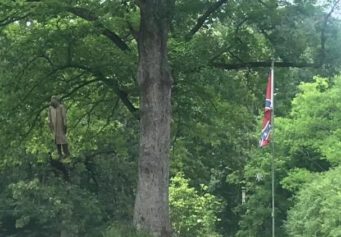Harvard Law School has become an epicenter in the national debate growing over the use of racist symbols on university campuses, but the symbols exist at schools throughout the nation. The questions remain, why should these racist symbols and logos be removed, what is their purpose and how are they used in training and conditioning the minds of students and society in general?
Under the hashtag #HarvardLawProtest, students are protesting the continued use of the school seal, which contains the Latin word veritas, which means truth, and an insignia consisting of three sheaves of wheat. The insignia of wheat was the family crest of Issac Royall Jr., a “wealthy and ruthless slaveowner” as described in The Altlantic, who also made his wealth from the slave trade and whose wealth funded the law school. In response to Black students placing black tape over the law school seal in locations on campus, someone defaced the portraits of all of the Black Harvard law professors by placing black tape over their faces. The law school has created a committee to assess the use of the slavery-related coat of arms, and is expected to make a decision by March.
Neutrality is a choice to maintain status quo of oppression #harvardlawprotest
— Lauren K (@CrassHysteria) December 4, 2015
“What’s frustrating is that my peers r reducing this to tape…if it’s about tape, it means you haven’t been listening.” #HarvardLawProtest
— Daisy Buchanan (@Cool_as_1s1s) December 4, 2015
Students and staff have issued their demands to change @Harvard_Law. Read them here and share: https://t.co/i3yItqZZcY #HarvardLawProtest
— RoyallMustFall (@RoyallMustFall) December 4, 2015
Students of color, low income backgrounds, and immigrants don’t have the choice to not pursue firm jobs #HarvardLawProtest
— Stanford Fraser (@Stanfordfraser) December 4, 2015
Diversity audit must be done and must be made public. #HarvardLawProtest
— Travis West (@WestOfTravis) December 4, 2015
“We don’t see ourselves reflected here, which makes us think one thing: we’re not valued” -Staff Member. #HarvardLawProtest #SupportHLSStaff
— C. Rob (@C_Rob919) December 4, 2015
Meanwhile, Harvard College just announced that it will discontinue using the title “house master” for the heads of their residential dorms, to a term that reflects 21st-century realities, as the New York Times reports. The term has clear connotations of slavery, hence the push to devise a new moniker.
Harvard is by no means the only educational institution that has managed to cling on to racial symbolism.
At the University of North Carolina at Chapel Hill stands a confederate monument known as Silent Sam. According to the university website, the monument was erected in 1913 in honor of the university 321 who served in the Confederate Army during the Civil War.
Following the removal of the Confederate flag from the statehouse grounds in Columbia, South Carolina, a number of universities have moved to address their own Confederate emblems and similar imagery, as The College Fix reported. For example, there is Clemson University in South Carolina, whose Tillman Hall is named after Benjamin Tillman, the governor of the state and later U.S. Senator, and a white supremacist who supported lynching and Black voter disenfranchisement. “Ben Tillman was complicit or directly responsible for the killing of many black people, an action for which he apparently felt no remorse. Why would we honor this legacy by retaining his name on one of the iconic buildings on campus?” wrote members of the faculty senate on their website.
At UC Berkeley in California, students are pushing for the renaming of Barrows Hall, named after former university president David Barrows, and LeConte Hall, named for Joseph and John LeConte. Barrows was an imperialist and colonialist who exploited Africa, while the LeConte brothers manufactured weapons and ammunition for the Confederacy.
This year, the University of Texas at Austin removed a statue of the Confederate president Jefferson Davis from a pedestal on campus, after a court rejected pleas from a Confederate heritage group, according to Fox News. However, statues of other Confederate leaders remain, including Confederate Gens. Robert E. Lee and Albert Sidney Johnston, and Confederate Postmaster General John H. Reagan.
In June, as Slate reported, the board of The Citadel voted to request that the South Carolina General Assembly amend a state law to allow the school to remove its Confederate naval flag from its chapel.
Yale University, for example, has a residential college named Calhoun College after John C. Calhoun, the seventh vice president of the United States and an ardent defender of slavery, among the most enthusiastic supporters of the evil institution.
At Princeton University, students have protested to remove the name of Woodrow Wilson from all buildings and institutions. Wilson was a racist who served as both president of Princeton and later as president of the U.S. He kept Black students completely out of the university during his tenure. And at the White House, Wilson segregated the federal civil service, supported the Ku Klux Klan, and even screened the racist film The Birth of A Nation at the White House.
Some may ask why it is important for these symbols to be removed from university campuses. In order to understand the power of these emblems, it is necessary to understand that they are part of the ideological framework that built these institutions. It is no mere coincidence that many of these educational institutions also serve as hostile racial environments for Black students.
When a university, or any other institution or organization for that matter, is built on white supremacy, racism and the oppression of Black people, that will be reinforced in the curriculum, the monuments, the names and faces on the wall, and its guiding principles. If those racist emblems and monuments to white supremacy remain, this means the university approves of them and all they stand for. And if there was no attempt to reconcile or address that violent and oppressive history, then the legacy remains and is perpetuated, treated as the normal state of affairs. And is this not what has been accomplished in our criminal justice system, our financial institutions, our police departments and all other institutions in which systemic racism is allowed to thrive?
Further, we are to assume that the young, impressionable minds of students will be inculcated with the principles and philosophies represented in those loathsome symbols. It is crucial that we remember history just as it happened. However, that does not mean that we should tolerate or glorify the oppression that took place, or worship the leaders in that legacy of oppression as heroes. First, we must acknowledge the damage and the source of the damage, then remove the sources of the harm. But if we do not wish to admit the symbols are creating harm, as they have for decades and centuries, then change will not occur, and the injustices will continue.



